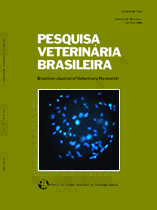 |
|
|
|
Year 2016 - Volume 36, Number 1001
|

|
Potential for in vitro mesoderm differentiation of Wharton’s jelly cells from ovine umbilical cord isolated in different culture media, 36(Supl.1):79-88
|
ABSTRACT.- Dias R.P., Teixeira M.F.S., Costa E.C., Farias A.C., Azevedo D.A.A., Aguiar T.D.F. & Pinheiro M.A. 2016. Potential for in vitro mesoderm differentiation of Wharton’s jelly cells from ovine umbilical cord isolated in different culture media. Pesquisa Veterinária Brasileira 36(Supl.1):79-88. Programa de Pós-Graduação em Ciências Veterinárias, Laboratório de Virologia, Faculdade de Veterinária, Universidade Estadual do Ceará, Av. Silas Munguba, 1700, Itaperi, Fortaleza, CE 60740-000, Brasil. E-mail: ronaldodias01@yahoo.com.br
The mammalian Wharton’s jelly of umbilical cord (WJUC) is a promising source of multipotent cells, providing advantages due to ethical implications, ease of collection and the absence of teratomas in pre-clinical trials. Ovine multipotent cells have already been isolated from various tissues, however there are no reports using umbilical cords in this species. This study aimed to investigate the best medium to transport the umbilical cord, to isolate and maintain ovine WJUC cells and to compare in vitro growth and mesodermal differentiation potential. Eight ovine umbilical cords were obtained during parturition, sectioned and transported in six different media: MEM, low glucose DMEM, M199, RPMI 1640, PBS and saline. For each transportation medium, four culture media were used and the tissue was explanted in 24-well plates and cultured in MEM, low glucose DMEM, M199 and RPMI 1640, all with 10% FBS. Every experiment was conducted with low-passage (P2), investigating MTT viability during four days and adipogenic, chondrogenic and osteogenesis differentiation was induced in vitro. The most effective transport medium (p<0.1) was low glucose DMEM. There was no bacterial or fungal contamination from collection. Cells from Wharton’s jelly of ovine umbilical cords collected at natural birth possess fibroblastic morphology and the capacity for in vitro differentiation into adipogenic, chondrogenic and osteogenic cell lines. MTT tests and in vitro differentiation experiments revealed that cell culture medium modulates the behavior of cells and is an important factor for proliferation and maintenance of multipotency. Low glucose DMEM was the most suitable medium for the isolation of cells from Wharton’s jelly of ovine umbilical cord. |
| |
|
|
| |
|
 |